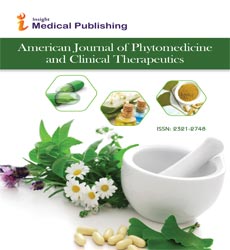ISSN : 2321-2748
American Journal of Phytomedicine and Clinical Therapeutics
Assessing the Role of Herbal and Plant-Based Remedies in the Treatment of Depression
Mohd Aizat*
1Department of Medicine, University of Washington, Washington, USA
- *Corresponding Author:
- Mohd Aizat,
Department of Medicine, University of Washington, Washington, USA
E-mail: aizat.md@gmail.com
Received date: September 16, 2024, Manuscript No. IPAPCT-24-19889; Editor assigned date: September 19, 2024, PreQC No. IPAPCT-24-19889 (PQ); Reviewed date: October 03, 2024, QC No. IPAPCT-24-19889; Revised date: October 10, 2024, Manuscript No. IPAPCT-24-19889 (R); Published date: October 17, 2024, DOI: 10.36648/2321-2748.12.3.291
Citation: Aizat M (2024) Assessing the Role of Herbal and Plant-Based Remedies in the Treatment of Depression. Am J Phytomed Clin Ther Vol.12 No.3: 291.
Description
A major global public health concern, clinical depression can result in suicidal thoughts and behaviours. Even though there are medical therapies for depression, only 60% of patients respond well to them and the remaining patients have side effects that force them to stop taking their medicine. Therefore, the development of a novel antidepressant with a unique mechanism of action and controllable adverse effects is urgently needed. Using plant-based traditional medicine or medicinal plants as alternative treatments for mental illnesses is one of the choices. Over forty species of medicinal plants with antidepressant properties were found through a thorough search of the literature; some of these are used in traditional medicine. Albizia zygia (DC.), J.F. Macbr., Calculus bovis sativus, Celastrus paniculatus willd., Cinnamomum sp., Erythrina velutina willd., Ficus platyphylla delile, Garcinia mangostana linn., Hyptis martiusii benth. and Polygonum multiflorum thunb. Were among the plant species mentioned [1-3]. These plants' antidepressant mechanisms were further described according to their modes of action, which included the regulation of the Hypothalamic-Pituitary-Adrenal (HPA) axis, the anti-oxidation system, the anti-inflammatory action, the modulation of different neurotransmitters, the neuroprotective effect.
Herbal approaches to depression
One of the most widespread mental illnesses, depression affects over 264 million people globally and has increased significantly in the last several decades. Because of the high rate of suicide and other issues associated with sadness and mental health, depression is currently one of the leading causes of death worldwide. A complicated condition, depression is brought on by a combination of environmental, genetic and multiple pathophysiological factors. Negative mood, loss of enthusiasm or enjoyment, tiredness, guilt, hopelessness, difficulties concentrating, problems eating and sleeping and suicidal thoughts are all signs of depression. Additionally, sadness frequently coexists with psychological symptoms like anxiety or panic attacks. An individual may experience severe dysfunction or poor functioning to meet the demands of their daily tasks at work, school, or with families as a result of these circumstances, which may be chronic or recurring. Depression has resulted in severe emotional suffering as well as a loss of productivity that has led to enormous financial losses. Several therapy approaches have been used to develop effective drugs for mental diseases in an effort to reduce this complex health and social load [4-6]. Monoamine Oxidase Inhibitors (MAOIs) like isocarboxazid, moclobemide and tranylcypromine, Norepinephrine Serotonin Reuptake Inhibitors (NSRIs) like duloxetine, levomilnacipran and venlafaxine, Tricyclic Anti- Depressants (TCAs) like amitriptyline, desipramine, imipramine and selective Serotonin Reuptake Inhibitors (SSRIs) like escitalopram, fluoxetine and paroxetine are among the psychiatric drugs currently used in treatment. Even though these medications were available, about half of the patients did not react adequately to them, making the primary therapy insufficient for the medications currently on the market.
Natural alternatives for depression
The slow-onset progressive action of conventional antidepressant medications usually takes two to eight weeks to reach the desired therapeutic effect. The Central Nervous System (CNS) side effects (anxiety, insomnia, sedation, nightmares), gastrointestinal side effects (constipation, dry mouth, increase/loss of appetite), difficulty falling asleep, cardiotoxicity, neurotoxicity, orthostatic hypotension and sexual dysfunction are also among the major adverse effects of antidepressants. Due to significant side effects, around half of depressed patients have begun to reduce their antidepressant prescription dosage or have even stopped taking psychiatric meds altogether. People's interest in employing alternatives that contain medicinal plant species has been influenced by these side effects as well as the high cost of medications. Traditional Chinese Medicine (TCM) and ayurveda are two examples of phytotherapy and traditional medicine that have long been used to improve wellness and general health in developing nations. Because allopathic treatment is not readily available to rural regions, these people rely significantly on traditional herbal medicine [7-10]. In fact, more than nineteenth-century medicine has been derived or originated from plants, making them one of the most significant sources of modern pharmaceuticals. Compared to traditional medications, medicinal plant species have shown a therapeutic role in treating a variety of psychological problems, including mental illnesses, with comparatively cheaper prices and fewer side effects. For instance, a number of phytochemical compounds that have been discovered from natural sources, including α-pinene, α- mangostin, myrsinoic acid and mogroside, have been found to have the potential to be new antidepressants or at the very least to be an alternative to improve the way depression is now treated. Understanding the possible mechanism of action of therapeutic plants that have been shown to have such biological effects is important.
References
- Kessler CS, Dhiman KS, Kumar A, Ostermann T, Gupta S, et al. (2018) Effectiveness of an Ayurveda treatment approach in knee osteoarthritis-A randomized controlled trial. Osteoarthritis Cartilage 26: 620-630.
[Crossref] [Google Scholar] [Indexed]
- Adra HJ, Zhi J, Luo K, Kim YR. (2022). Facile preparation of highly uniform type 3 resistant starch nanoparticles. Carbohydr Polym 294: 119842
[Crossref] [Google Scholar] [Indexed]
- Balachandran P, Govindarajan R. (2005). Cancer-an ayurvedic perspective. Pharmacol Res 51: 19-30.
[Crossref] [Google Scholar] [Indexed]
- Adeleke BS, Babalola OO (2021). Roles of endosphere microbes in agriculture – A review. J Plant Growth Regul 41: 1411-1428.
- Ahanger MA, Qin C, Maodong Q, Dong XX, Ahmad P, et al. (2019) Spermine application alleviates salinity induced growth and photosynthetic inhibition in Solanum lycopersicum by modulating osmolyte and secondary metabolite accumulation and differentially regulating antioxidant metabolism. Plant Physiol Biochem 144: 1–13.
[Crossref] [Google Scholar] [Indexed]
- Alexander M, Ang QY, Nayak RR, Bustion AE, Sandy M, et al. (2022) Human gut bacterial metabolism drives Th17 activation and colitis. Cell Host Microbe 30:17-30
[Crossref] [Google Scholar] [Indexed]
- Ashleigh T, Swerdlow RH, Beal MF (2023) The role of mitochondrial dysfunction in Alzheimer’s disease pathogenesis. Alzheimer’s Dement 19:333-342.
[Crossref] [Google Scholar] [Indexed]
- Cai Y, Chai Y, Fu Y, Wang Y, Zhang Y, et al. (2021) Salidroside ameliorates Alzheimer’s disease by targeting NLRP3 inflammasome-mediated pyroptosis. Front Aging Neurosci 13:809433.
[Crossref] [Google Scholar] [Indexed]
- Chan K, Shaw D, Simmonds MS, Leon CJ, Xu Q, et al. (2012) Good practice in reviewing and publishing studies on herbal medicine, with special emphasis on traditional Chinese medicine and Chinese materia medica. J Ethnopharmacol 140:469-475.
[Crossref] [Google Scholar] [Indexed]
- Chen M, Wang T, Yue F, Li X, Wang P, et al. (2015) Tea polyphenols alleviate motor impairments, dopaminergic neuronal injury, and cerebral α-synuclein aggregation in MPTP-intoxicated parkinsonian monkeys. Neuroscience 286:383-392.
[Crossref] [Google Scholar] [Indexed]

Open Access Journals
- Aquaculture & Veterinary Science
- Chemistry & Chemical Sciences
- Clinical Sciences
- Engineering
- General Science
- Genetics & Molecular Biology
- Health Care & Nursing
- Immunology & Microbiology
- Materials Science
- Mathematics & Physics
- Medical Sciences
- Neurology & Psychiatry
- Oncology & Cancer Science
- Pharmaceutical Sciences
